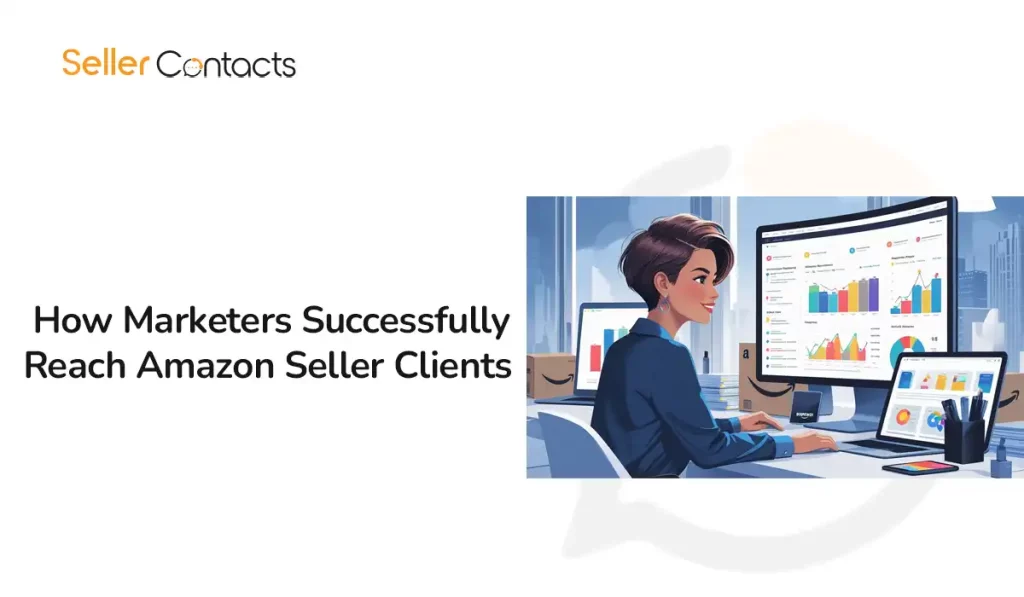How Marketers Successfully Reach Amazon Seller Clients

Amazon sellers aren’t your average audience. They’re busy, data-driven, and laser-focused on one thing: growing their business. If you’re marketing services like PPC management, product sourcing, software tools, or logistics, reaching Amazon seller clients takes a very different approach compared to traditional lead generation.
It’s not about blasting ads into the void.
It’s about precision targeting, understanding seller behavior, and speaking their language.
Today, we’ll break down exactly how smart marketers consistently connect with Amazon sellers — and how tools like Seller Contacts can make your outreach faster, easier, and far more effective.
Why Reaching Amazon Sellers is a Unique Challenge
Selling to Amazon sellers isn’t like selling to regular consumers or even other businesses.
Here’s why:
- High Skepticism: Sellers are bombarded daily with pitches. They’ve heard it all.
- Time-Conscious: Most sellers are juggling inventory, ads, fulfillment, and customer service — they won’t entertain vague pitches.
- Results-Driven: Sellers want proof, not promises. They invest where they see clear ROI.
- Niche-Specific Needs: A service that helps a beauty brand might not help a supplement brand.
To win their attention — and their trust — your approach must be tailored, data-backed, and deeply relevant.
What Successful Marketers Know About Targeting Sellers
The top-performing marketers don’t just send cold emails or launch random campaigns.
They strategically reverse-engineer who they want to reach, what those sellers care about, and when they’re ready to buy services.
Key factors they focus on:
- Seller Size Matters: A seller doing $50K a year needs different services than one doing $5M.
- Product Category Insights: Targeting a kitchen goods seller requires a different pitch than targeting a tech accessories seller.
- Geographic Relevance: Some services are location-specific, especially for logistics, 3PLs, or local compliance regulations.
How Data Supercharges Your Outreach
You can’t reach Amazon sellers effectively if you don’t know who they are.
That’s why successful marketers start with rich, accurate data — not guesswork.
Good seller databases provide details like:
- Seller name and company
- Product categories they sell in
- Estimated revenue range
- Location (domestic vs international)
- Amazon marketplace focus (US, UK, EU, etc.)
- Contact information (email, website, LinkedIn)
Without this data, you’re sending blind messages into a black hole.
With this data, you’re crafting personalized, relevant, compelling outreach that sellers actually respond to.
And that’s exactly what Seller Contacts delivers.
Where Most Marketers Fail — And How To Avoid It
Many marketers make three critical mistakes when trying to reach Amazon sellers:
- Generic Messaging: Sending the same cold pitch to every seller, regardless of size, niche, or pain points.
- Poor Timing: Approaching sellers during busy seasons like Prime Day without adapting the message to their current mindset.
- Lack of Research: Not bothering to understand the seller’s products, branding, or growth stage before reaching out.
To succeed, you need to:
- Personalize every message with seller-specific details.
- Offer solutions based on where they are in their growth journey.
- Time your outreach carefully — slow seasons are often the best for service pitches.
Tip: After Amazon Prime Day or Q4 holiday season, many sellers evaluate new vendors and service providers.
That’s your window.
The Role of Seller Contacts in Reaching Amazon Sellers
Seller Contacts was built specifically to solve this problem — helping marketers and service providers connect with the right Amazon sellers faster and more intelligently.
With Seller Contacts, you can:
- Filter sellers by product category, revenue range, location, and marketplace.
- Download verified seller lists for targeted campaigns.
- Access direct contact information to enable personalized outreach.
- Map seller activity to identify high-growth opportunities.
Best Practices for Contacting Amazon Sellers
Once you have the right data, your outreach strategy matters.
Here’s what works best:
- Short, Personalized Introductions: Show you understand their business right away.
- Clear Value Proposition: Tell them exactly what problem you solve — in less than 10 seconds.
- Social Proof: Mention successful brands you’ve helped, if possible.
- Relevant Timing: Align your outreach to sellers’ slower cycles or post-peak seasons.
- Follow Up Thoughtfully: Sellers are busy. A respectful, helpful follow-up can make the difference.
Pro Tip:
Using personalization tokens like “[Seller Store Name]” in your emails can increase open rates by up to 29%, according to industry studies.
The Future: Smarter, More Personalized Seller Marketing
The landscape of Amazon selling is evolving — and so is the way you must market to sellers.
In 2025 and beyond, successful marketers will:
- Use AI-enhanced lead scoring to prioritize seller prospects.
- Leverage behavioral data to time outreach perfectly.
- Offer category-specific solutions rather than broad service packages.
- Build long-term partnerships with sellers, not just quick transactions.
Those who embrace precision targeting and hyper-personalization will thrive.
Those who stick to spray-and-pray methods will be left behind.
Reach the Right Amazon Sellers with Seller Contacts
If you’re serious about growing your client base among Amazon sellers, you can’t afford to rely on outdated, incomplete lists or guesswork.
Seller Contacts gives you the world’s largest, most accurate database of Amazon sellers — fully filtered, verified, and ready to power your next outreach campaign.
Start your journey today. Request a demo with Seller Contacts now.
Make your next campaign the one that breaks through.
